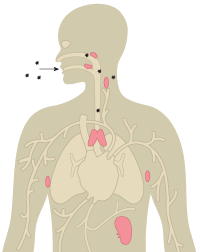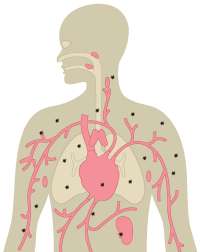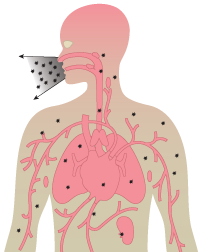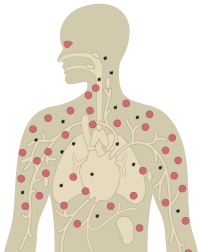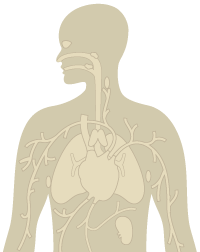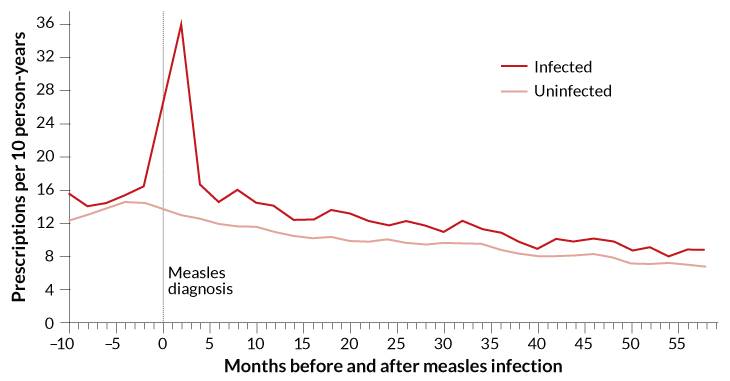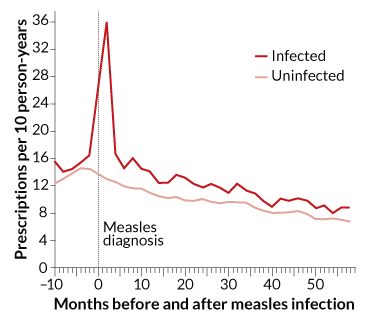Measles erases the immune system’s memory
Beyond the rash, the infection makes it harder for the body to remember and attack other invaders
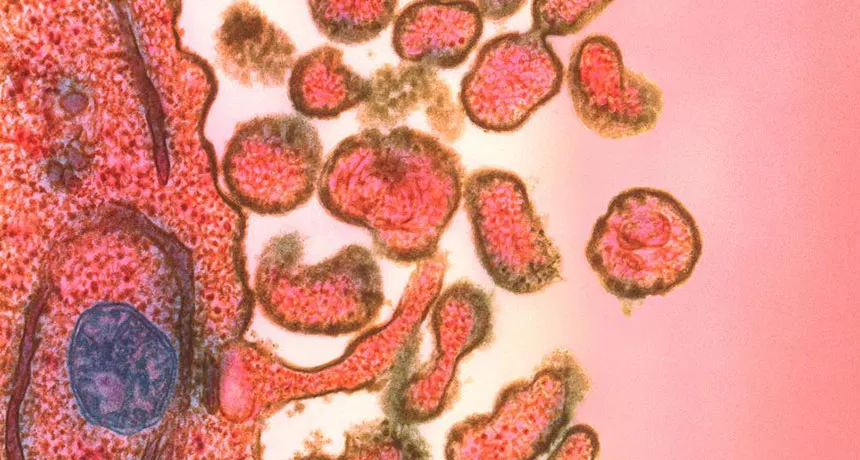
MEMORY WIPE Measles virus particles bud out from an infected cell (left) after replicating inside the cell in this colored electron micrograph.
NIBSC/science source
The most iconic thing about measles is the rash — red, livid splotches that make infection painfully visible.
But that rash, and even the fever, coughing and watery, sore eyes, are all distractions from the virus’s real harm — an all-out attack on the immune system.
Measles silently wipes clean the immune system’s memory of past infections. In this way, the virus can cast a long and dangerous shadow for months, or even years, scientists are finding. The resulting “immune amnesia” leaves people vulnerable to other viruses and bacteria that cause pneumonia, ear infections and diarrhea.
Those aftereffects make measles “the furthest thing from benign,” says infectious disease epidemiologist and pathologist Michael Mina of Harvard University. “It really puts you at increased susceptibility for everything else.” And that has big consequences, recent studies show.
Details about which immune cells are most at risk and how long the immune system seems to suffer — gleaned from studies of lab animals, human tissue and children before and after they had measles — have created a more complete picture of how the virus mounts its sneak attack.
This new view may help explain a larger-than-expected umbrella of safety created by measles vaccination. “Wherever you introduce measles vaccination, you always reduce childhood mortality. Always,” says virologist Rik de Swart of Erasmus University Medical Center in the Netherlands. The shot prevents deaths, and more than just those caused by measles. By shielding the immune system against one virus’s attack, the vaccine may create a kind of protective halo that keeps other pathogens at bay, some researchers suspect.
Locking onto a target
After an infected person coughs or sneezes, the measles virus can linger in the air and on surfaces for up to two hours, waiting to make its way into the airways of its next victims. Once inside, the virus is thought to target immune cells found in the mucus of the nose and throat, the tiny air sacs in the lungs or between the eyelids and cornea. These immune cells are decorated with a protein called CD150 that allows the virus to invade, experiments on animals suggest.
The virus quickly replicates inside the cells, then spreads to places packed with other immune cells — bone marrow, thymus, spleen, tonsils and lymph nodes. “The virus has an enormously strong predilection to infect cells of the immune system,” says Bert Rima, an infectious disease researcher at Queen’s University Belfast in Northern Ireland. Rima and colleagues traced the immune system invasion in preserved human tissue, reporting results in 2018 in mSphere. Eventually, newly made viral particles move into the respiratory tract, where they can be coughed out to sicken more people.
An acute measles infection, which usually lasts several weeks, can sometimes bring ear infections, pneumonia and, rarely, a deadly brain swelling. On their own, those are worrisome outcomes, says Anthony Fauci, director of the National Institute of Allergy and Infectious Diseases in Bethesda, Md. But the loss of immune cells can also leave people vulnerable to infections that the immune system would normally be able to handle.
In 2013, de Swart and colleagues saw an opportunity to study the immune effects of the virus in children who are part of an insular community of Orthodox Protestants in the Netherlands, called the Dutch Bible Belt. Parents there refuse vaccinations, a decision that ushers in regular bouts of measles. The community’s last measles outbreak ended in 2000; it was just a matter of time before the virus took hold again.
The researchers got permission from parents to take blood samples from healthy, unvaccinated children to study their immune cells. Then, the researchers waited for an outbreak, so they could test the kids again after an infection.
De Swart didn’t have to wait long. Just as the researchers began collecting blood, an outbreak emptied classrooms, packing sick siblings into dark living rooms to protect their sensitive eyes. As the virus ripped through the community, de Swart and colleagues collected before and after samples from 77 children who contracted measles.
“The virus preferentially infects cells in the immune system that carry the memory of previously experienced infections,” de Swart says. Called memory B and T cells, these cellular protectors normally remember threats the body has already neutralized, allowing the immune system to spring into action quickly if those threats return. After a measles infection, the numbers of some types of these memory cells dropped, creating an immune amnesia, the researchers reported in 2018 in Nature Communications.
Long road to recovery
The immune system might take months, or even years, to bounce back from this memory loss. Researchers including de Swart and Mina compared health records of U.K. children from 1990 to 2014. For up to five years after their bout of measles, children who had previously had the virus experienced more diagnosed infections than children who hadn’t. Children who’d had measles were 15 to 24 percent more likely to receive a prescription for an infection than children who never had measles, the researchers reported in 2018 in BMJ Open.
Mina and colleagues found similar results for deaths from nonmeasles infections in children in England, Wales, the United States and Denmark, before and after the introduction of the measles vaccine. When measles was rampant, children were more likely to die from other infections.
When the researchers looked out several years after the measles, the connection between measles and nonmeasles deaths grew stronger (SN: 5/30/15, p. 10). “Every little blip in the mortality data could be explained by the measles incidence data over the previous 30 months,” Mina says. It’s not clear how the immune system eventually recovers its memories. With new methods that can measure these cellular memories, Mina and others hope to understand that rebuilding process.
Most children get over measles uneventfully. “The immune system is incredibly resilient,” de Swart says. Still, measles is not an innocent childhood disease. For some people, the consequences can be severe. But there’s a vaccine for that. “At the end of the day, we know how to prevent this potentially lethal disease,” Mina says. “It’s so simple.”
